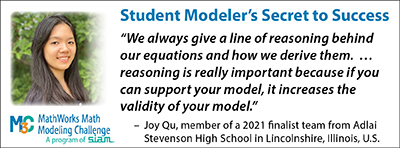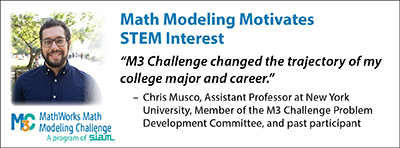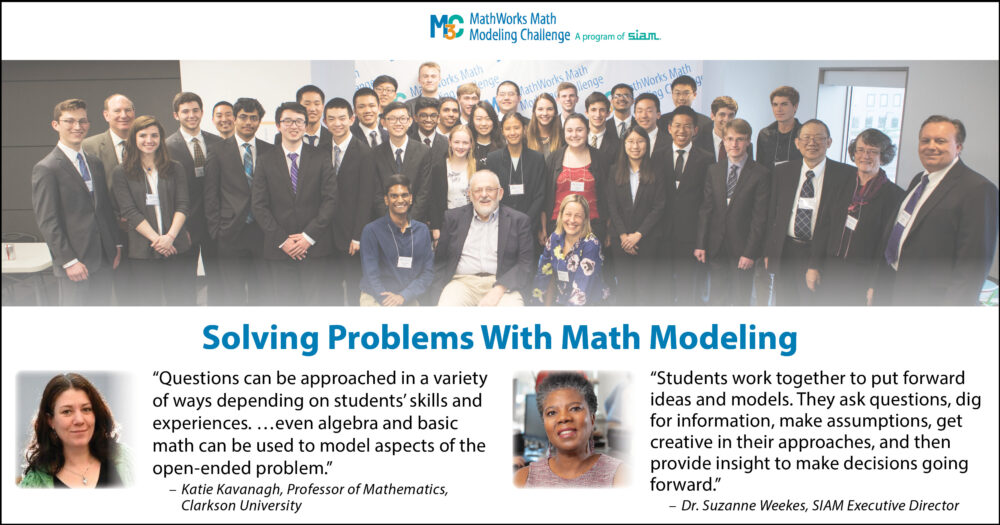Mathematical modeling refers to the process of creating a mathematical representation of a real-world scenario to make a prediction or provide insight. There is a distinction between applying a formula and the actual creation of a mathematical relationship. Some graphical illustrations of the modeling process can be seen on this one-page flyer.
Real-world, messy problems can be approached with mathematics, resulting in a range of possible solutions to help guide decision making. Students and teachers are sometimes uncomfortable with the notion of math modeling because it is so open-ended. So much unknown information seems prohibitive. And how do you decide which factors are most relevant? But it is this open-ended nature of real-world problems that leads to building and applying problem solving skills, creativity, and innovation in mathematics.
Math modeling obliterates the question “Why do I need math?” by demonstrating the value and importance of math in approaching big problems found in our communities, regions, and world. Identifying the important variables and quantifying them—even with assumptions and incomplete information—can lead students to insights and understanding that have reason and structure.
It’s a Process
Mathematical modeling can be thought of as an iterative process made up of the following components. (Note that the word “steps” is intentionally avoided: there is no prescribed ordering—some may occur simultaneously, and some may be repeated.)
- Identify the Problem—Be specific in defining what you want to find out.
- Make Assumptions and Identify Variables—It is impossible to account for all the important factors in a given situation; you must make choices about what to incorporate in your representation of the real world. Making assumptions helps reveal the variables to be considered and reduces their number by deciding not to include everything. Relationships between variables will emerge based on observations, physical laws, or simplifications.
- Do the Math—Eventually, a relationship between input and output will allow for a solution to be found.
- Analyze and Assess the Solution—Consider the results and insights gained from the model. Does the answer make sense?
- Iterate—Usually the model can be refined, and the process can be repeated to improve performance.
- Implement the Model and Report Results—Make the model understandable to others.
Pitfalls to Avoid
The biggest pitfall in developing a reasonable model is often time management. When modeling is new to students, it is easy for them to become overwhelmed, and they may spend too much time “in the weeds.” To define a succinct problem statement, students need to brainstorm, and they should be encouraged not to get rid of any ideas. However, there are times when students may get caught up in trying to include variables or relationships in their model that are not tractable or where data is unavailable. If this happens, students should assume and move on, making sure they come back to those assumptions after they have gone through the entire modeling process. Having said that, sometimes students include unneeded assumptions in their documentation that are never explicitly used in the modeling process. This can cause them to lose valuable time and could detract from the presentation of the solution. Students must try not to get off track while creating models, particularly by making choices or assumptions that undermine the quality of the solution.
When students are in a time crunch, apprehension may lead to mathematical relationships that are removed from reality being introduced, even to the point of being nonsense! For example, students may form an additive relationship between the key variables they identified but the units are meaningless (for example, adding dollars to time to get a model for resources). Coefficients are often used in models that also do not reflect units properly or there is no justification as to why they were chosen. Other times, students may have a sound idea for a mathematical relationship, but they overcomplicate it to make the mathematics look more sophisticated than it is (for example, introducing a triple integral when really addition is appropriate). This is another reason leaving time for reflection is critical, so that students can read over their entire solution and ask themselves “Does this make sense?”.
Dealing with data can also be overwhelming. Students may have a brilliant idea for a model but cannot find the data they need to move it forward (again, at this point they should make an assumption and stop wasting time looking). Other times, datasets may be prohibitively large, and students are not equipped with the tools to interpret key trends. Linear regression or high-degree polynomials are often used to fit data without any sound reason and then used as predictors. The connection to the underlying physical problem that instigated the data fitting can get lost, or the quality of the fit is ignored completely due to relief at having done something that seemed to work.
All the above pitfalls (which are by no means an exhaustive list) can be amended if the team reflects on the quality of their work. If an assumption seemed way off base, students could report out the identified weaknesses of their approach and point the way toward improvements, even if they do not have the means or access to the information to do so. Even better, a sensitivity analysis can help a student assess the robustness of their model and make comments on its applicability. Much of this goes back to time management.
An Opportunity for Students to Engage in Math Modeling
MathWorks Math Modeling Challenge (M3 Challenge) is an annual free online contest in which high school juniors and seniors and sixth form students work in teams of 3-5 to solve an open-ended problem about a real-world issue in 14 continuous hours over Challenge weekend. The Challenge problem is completely unknown until teams download it during Challenge weekend. The use of online collaboration tools and resources is encouraged.
Scholarships totaling £75,000+ (will be awarded in 2022. Extra credit awards are available for teams who choose to write or employ outstanding code as part of their solution. The competition has given $1.65 million+ to date.
A program of Society for Industrial and Applied Mathematics (SIAM) that is funded by leading technical computing software developer MathWorks, M3 Challenge motivates students to study and pursue careers in applied mathematics, computational science, data science, and technical computing. It has been a virtual competition since its inception in 2006. Past competition topics include issues such as the transition of trucking from diesel to electric, universal internet access, substance abuse, food insecurity, plastic recycling, and car sharing.

From Judges, Coaches, and Past Participants
Submissions are judged by an international panel of 150 primarily Ph.D.-level mathematicians, and almost every team receives specific feedback on their submission from the judges who read their papers during rigorous assessments. “The questions can be approached in a variety of ways depending on students’ skills and experiences,” says problem development committee member and judge Dr. Katie Kavanagh of Clarkson University in Potsdam, New York. “For example, participants may use simulation and programming, probability and statistics, or even algebra and basic math to model aspects of the open-ended problem. We are always eager to see how the students approach the issue,” says Kavanagh. “They offer unique perspectives on what factors are important to consider, particularly at that critical, transitional time in their own lives and influenced by their unique circumstances.”
Joy Qu, a member of a 2021 finalist team from Adlai Stevenson High School in Lincolnshire Illinois, was asked about the secret to the team’s success. “We always give a line of reasoning behind our equations and how we derive them. So I think reasoning is really important because if you can support your model, it increases the validity of your model.”
David Stein is a teacher at Montgomery Blair High School in Silver Spring, Maryland who has coached multiple finalist teams in M3 Challenge. He believes that teachers can influence students to study and pursue STEM careers and can demonstrate the interdisciplinary nature of the sciences by basing rigorous lessons on real-world issues and problems, focusing students’ attention on communication and writing, and providing opportunities like M3 Challenge for them to showcase their work.
M3 Challenge has had a profound impact on many of its participants, including Dr. Chris Musco, a 2008 M3 Challenge finalist who is now head of the competition’s technical computing judging and a member of the problem development committee. “Being involved in this program as a judge and using my experience and perspective to help shape the problem the students will work on is really exciting,” says Musco, assistant professor in the Tandon School of Engineering at New York University. “M3 Challenge changed the trajectory of my college major and career, and it’s great to play a part in doing that for the students who are participating now.”

“For M3 Challenge, students work together and put forward ideas and models—some teams even include computer code – toward a solution or an approach to the problem presented. Every year we are blown away by the work produced by teams in just 14 hours,” said Dr. Suzanne Weekes, executive director at SIAM. “Problem topics are relevant and meaningful – for example the 2021 topic of reliable access to the internet for all, which became so prominent and important during the pandemic. Students are solving real problems by asking questions, digging for information, making assumptions to get started, getting creative in their approaches, and then providing insight about the issue that can be used to make decisions going forward.”
“Every year without fail, we hear from students who refer to their participation in M3 Challenge as a transformative experience that helped open their eyes to how important, useful, and valuable the application of mathematics can be,” said Michelle Montgomery, M3 Challenge program director at SIAM. “I am confident that this year’s Challenge will do the same.”
For rules, resources, and to register visit M3Challenge.siam.org.
Register by February 18, 2022
Challenge weekend (Friday through Monday): February 25-28, 2022
*Much of the content for this article was written by Katie Kavanagh and Ben Galluzzo of Clarkson University, and is based on ideas presented in GAIMME: Guidelines for Assessment and Instruction in Mathematical Modeling Education, Second Edition, Sol Garfunkel and Michelle Montgomery, editors, COMAP and SIAM, Philadelphia, 2019.

















Your thoughts